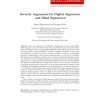Free Online Productivity Tools
i2Speak
i2Symbol
i2OCR
iTex2Img
iWeb2Print
iWeb2Shot
i2Type
iPdf2Split
iPdf2Merge
i2Bopomofo
i2Arabic
i2Style
i2Image
i2PDF
iLatex2Rtf
Sci2ools
118
click to vote
JOC
2000
2000
Security Arguments for Digital Signatures and Blind Signatures
Abstract. Since the appearance of public-key cryptography in the seminal DiffieHellman paper, many new schemes have been proposed and many have been broken. Thus, the simple fact that a cryptographic algorithm withstands cryptanalytic attacks for several years is often considered as a kind of validation procedure. A much more convincing line of research has tried to provide "provable" security for cryptographic protocols. Unfortunately, in many cases, provable security is at the cost of a considerable loss in terms of efficiency. Another way to achieve some kind of provable security is to identify concrete cryptographic objects such as hash functions with ideal random objects and to use arguments from relativized complexity theory. The model underlying this approach is often called the "random oracle model." We use the word "arguments" for security results proved in this model. As usual, these arguments are relative to wellestablished hard algorithmic prob...
Related Content
| Added | 19 Dec 2010 |
| Updated | 19 Dec 2010 |
| Type | Journal |
| Year | 2000 |
| Where | JOC |
| Authors | David Pointcheval, Jacques Stern |
Comments (0)

